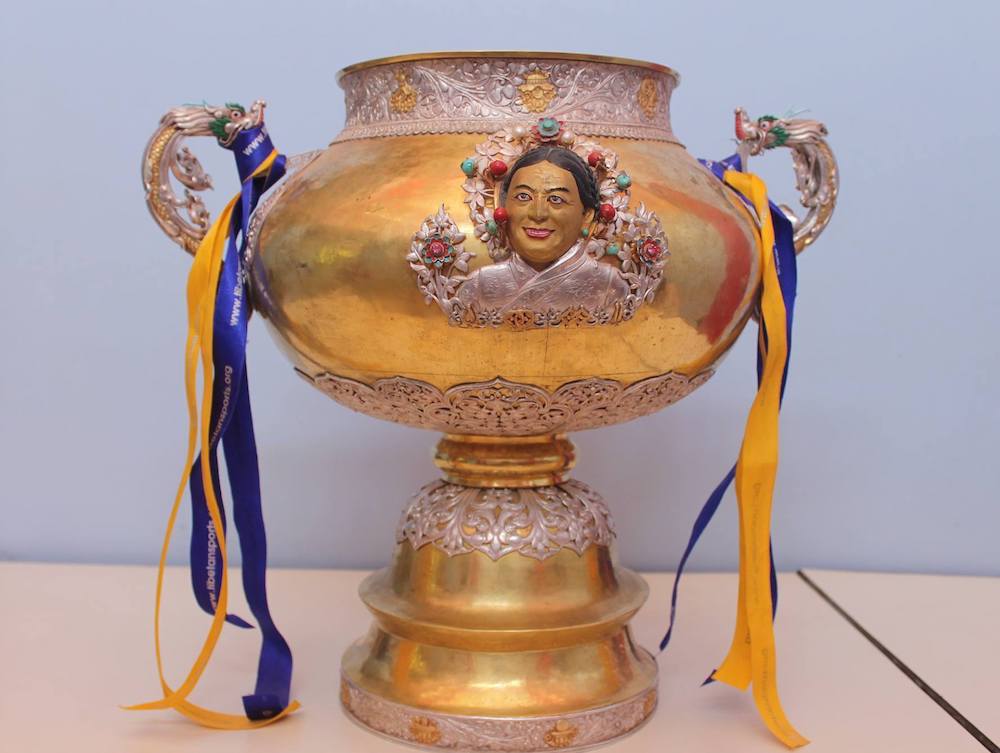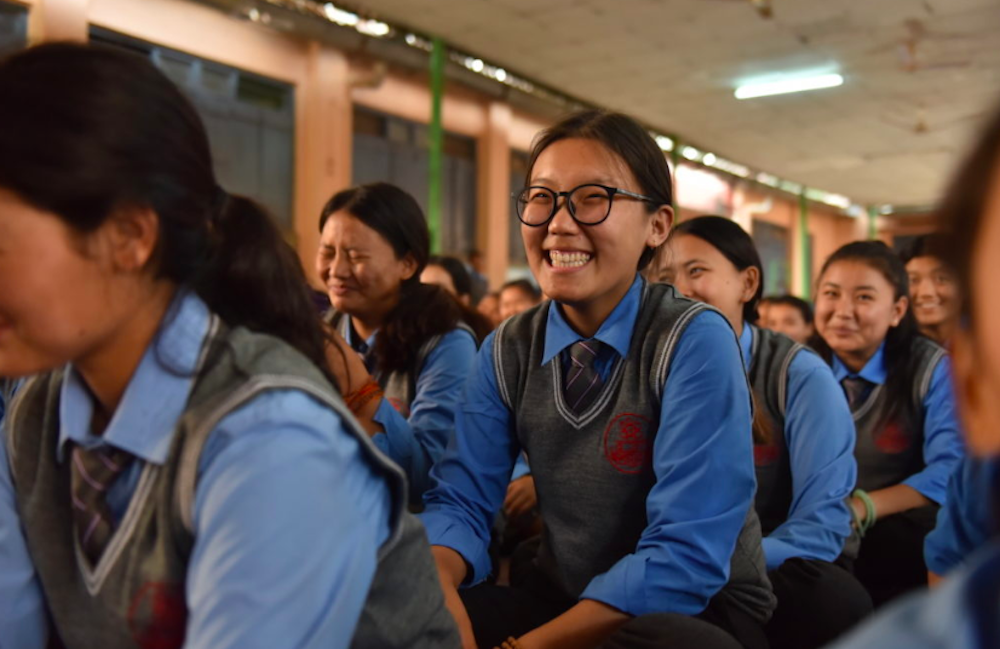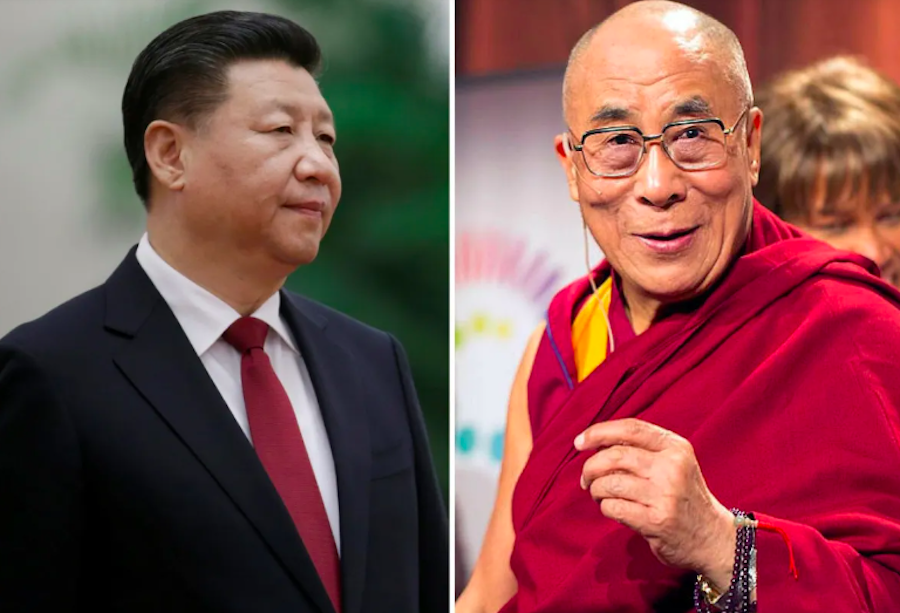By Colette Davidson
“This is one of the most important Tibetan events of the year. We are remembering and honoring all the Tibetans who put their lives on the line to resist the Chinese oppression and occupation. We’re letting the Chinese government know that our resistance continues.”
Tenzin, a soft-spoken young woman from Richfield, becomes passionate, almost forceful, when she talks about Tibetan National Uprising Day. She is not alone. She, and more than eight-hundred others, assembled at the State Capitol Rotunda in St. Paul on Saturday morning to show their solidarity against the current Chinese persecution of innocent Tibetans and the kidnapping of one of their religious leaders through song, prayer and protest.
As parents pinned “Free Tibet” cloths to their children’s backs, a visiting student group from Vanderbilt University circulated through the crowd soliciting signatures for a petition to release the Panchen Lama. Students from the Tibetan Cultural School (TCS) in St. Paul then led the crowd in singing the Tibetan National Anthem, followed by a traditional Long Life Prayer for His Holiness the Dalai Lama, initiated by monks from the Gyuto Wheel of Dharma Monastery, in an attempt to ensure his long life and ability to serve his people. As the Dalai Lama approaches his 73rd birthday, many Tibetans worry about what will become of their country when he is no longer able to lead. This fear, combined with Tibet’s forty-eight year struggle against the Chinese government, brought many at the State Capitol to tears.
“Like every individual in the world, we desire freedom,” said Deden, from Minneapolis, “we simply want our country back—that’s our message.”
Tsewang Ngodup, Director of the Tibetan American Foundation of Minnesota (TAFM), then read the statement of His Holiness, which he writes every year for Uprising Day. As in previous years, the Dalai Lama insisted on Tibet’s autonomy in China, versus its independence from it, and urged the Tibetan and international communities to continue peacefully supporting the Tibetan issue.
In an attempt to enliven the somewhat somber crowd, some of the more radical local Tibetan and non-Tibetan leaders engaged in a hearty dose of rebel-rousing. Kunsang Choni Lhewa, Regional Tibetan Women’s Association Vice President, encouraged the crowd to continue their support of a free Tibet. Then, with fists shaking in the air, General Secretary of the Regional Tibetan Youth Congress, Jigme Ugen called for an independent and free Tibet, sending the crowd into a fit of chants of “Bhod Rangtsen” (“Free Tibet”), as Tibetan flags and banners circled and swayed. “Tibetans are prepared to bear any burden in order to regain our country and our freedom…If China wants the struggle over Tibet to be a fight to the death, the Tibetan Youth Congress welcomes it!”
James Cohen, a democrat planning to run against Norm Coleman for U.S. Senate, used his past experiences and interest in Tibet, Nepal and India to appeal to the crowd. “The time for action is now…There’s no more debate about oppression and torture against the Tibetans,” he said, “we must insist on an accelerated negotiation between China and His Holiness. We must continue to speak out and to pressure China.”
Drums roared once more as the TCS band played Longsho, the Tibetan Uprising song, bringing everyone to their feet and ready to march the streets of downtown St. Paul. While most people in the demonstration were Tibetan, many Tibetan sympathizers attended Saturday’s event in support. Taylor Imboden, who came to Minnesota for the week to learn about Tibetan culture as part of Vanderbilt University’s Alternative Spring Break program, was overwhelmed by the emotion of the demonstration. “It’s been unbelievable…seeing all these people, this issue now has a face. The masses of people have brought everything to life,” she said, “Everyone’s outlook is so positive. We feel so charged to go back and do something.”
Once everyone was out the door, the mass of people took to the streets in boisterous protest. Some held banners reading, “Save Tibet,” or “China Stole My Identity,” while others carried national flags and bullhorns. Throughout the crowd, several people started chants. “What do we want? Free Tibet. When do we want it? Now!” as well as, “Long live, the Dalai Lama! Release, release, the Panchen Lama!” and “Stop the killing in Tibet!”
While the Tibetan community worldwide is famous for its peaceful, silent demonstrations, National Uprising Day is a time to be vocal, and marks 48 years of protest against the Chinese. National Uprising Day remembers those who lost their lives during China’s invasion and illegal occupation of Tibet in 1959. Since that day, over 1.2 million Tibetans have died through massacre, torture and starvation and more than 6,000 monasteries have been destroyed, according to the Tibetan government-in-exile.
The Dalai Lama has lived in exile since the 1959 Chinese invasion, and in 1989 identified a child named Gedhun Choekyi Nyima as the Panchen Lama, Tibet’s second highest spiritual leader. The Chinese claimed that a different child, Gyancain Norbu, was the Panchen Lama. In 1995, when he was six years old, the Panchen Lama identified by the Dalai Lama and his family were abducted by the Chinese government and have not been seen since. It is believed that the Chinese, who have admitted to his kidnapping, are taking the Panchen Lama away from his necessary Tibetan spiritual studies and instead are brainwashing him to support Chinese domination of Tibet. The Chinese government says that Gedhun Choekyi Nyima and his family are living under a secret identity for privacy and safety.
The march headed back to the State Capitol steps for more chants and prayers before everyone dispersed. Many went on to TAFM, where lunch was provided by TAFM, RTYC and TWA, and the film, “Tibetan Refugees” was shown, highlighting the original Uprising Day in Tibet. A panel discussion followed, where crowd members were encouraged to ask questions about National Uprising Day, the current situation in Tibet and what people of all generations can do to continue fighting for Tibet.
While Tibetans are split on the notion of an autonomous Tibet versus an independent one, all were united in St. Paul for the anniversary of National Uprising Day. Amidst all the chanting and urgings to fight, one message remained clear to the crowd, especially for a woman named Tsering. “We want to make sure everyone knows about China,” she said, “we are here to bring awareness.”
This event’s programs were jointly organized by TAFM, RTYC and TWA.









